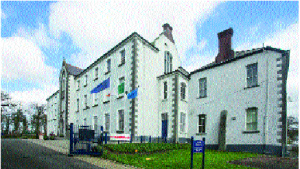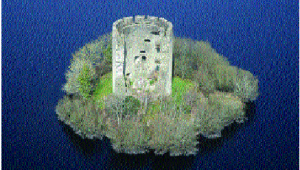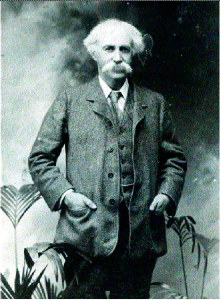Cavan County Museum
Published in Issue 5 (September/October), Reviews, Volume 22Cavan County Museum inhabits a nineteenth-century house that was once home to a gentry family and then a convent. The exhibition area is spread over three floors and a good tip is to take the lift to the top floor and then work your way down. The museum overall, like its building, is stately and airy. The designer has made full use of the space available and there is an abundance of information panels, interactive screens, mannequins and so on throughout.

Cavan County Museum occupies a nineteenth-century house that was once home to a gentry family and then a convent.
The top floor is devoted to the history of the recently conserved Clough Oughter castle. It began as a crannog, a stronghold of O’Reilly kings, until Walter de Lacy built a castle on it. The story of the castle follows that of Ireland through war, conquest and plantation. It was the last Irish stronghold to surrender to Cromwell’s forces in April 1653, and Cavan was one of the original Ulster Plantation counties. There is good use here of photographs and models to give a sense of being inside the castle. On this floor also is a side-room devoted to the nuns who once occupied the building, displaying artefacts from all aspects of their life, from novice to schoolteacher. Next door is a room devoted to the memory of Percy French, whose song Come back, Paddy Reilly made Ballyjamesduff internationally famous.

The recently conserved Clough Oughter castle, the last Irish stronghold to surrender to Cromwell’s forces in April 1653. The top floor is devoted to its history.
The next floor down contains the main exhibition area. There are seven galleries here, all occupying rooms running off the main corridor: archaeology; medieval; seventeenth century; Phyllis Faris; the Great Famine; Farnham; and Folklife. The Phyllis Faris gallery is devoted to her collection of early twentieth-century dresses and uniforms, while the Farnham gallery is devoted to the Maxwell family, who were the earls of Farnham. Apart from the latter two, the other galleries take you through the county’s history from ancient to recent times. Panels and interactive screens provide information, voices and sound effects to add another dimension to the experience.
Along the corridor is a ‘wall of fame’ of famous sons of Cavan, such as the American General Sheridan, Edgar Allen Poe and Henry James. Among the oldest artefacts on display are axeheads and pottery from the Neolithic and the Bronze Age. Of particular interest is the Corleck Head. This revolves inside its display cabinet, allowing you to see all three faces. Of equal interest are the sheela-na-gigs and other stone carvings in the medieval section.

One room is devoted to the memory of Percy French, whose song Come back, Paddy Reilly made Ballyjamesduff internationally famous.
As you wander from one gallery to the next, things to look out for include the Hugh Gough collection of pistols, rifles and swords, a set of uniforms that belonged to Col. Saunderson and memorabilia of Major-General Oliver Nugent (feat-ured in the last WWI special issue). Nearby is a magnificent collection of official weights and measures made of brass that was once used by the county council. The Farnham gallery presents Anglo-Irish gentry life, from agricultural to social pursuits. In one cabinet is the official invitation to the eleventh earl of Farnham to attend the coronation of George V, while across the room are the robes and coronet that he wore for the occasion.
At the other end of the social scale, rural society is represented in the Famine and Folklife galleries. The latter is a lively and imaginative representation of country life in the nineteenth century, with a full-size replica of a thatched cottage and a variety of tools and implements on display. The area devoted to the Famine is a much grimmer affair, as Cavan was badly affected. Particularly moving is the display of shoes dating from this period found in the Cavan workhouse. Mass emigration was a result of that disaster and there is a good exhibition on emigration out of the county from that time until the present, beginning with the recreation of a railway station waiting-room.

The Corleck Head, which revolves inside its display cabinet, allowing visitors to see all three faces.
The stairway itself is a gallery displaying various items such as oil paintings of the Maxwell family, a replica of the ancient Ralaghan figure and photographs on the walls and landings. Once on the ground floor, you can visit the gallery devoted to the Gaelic Athletic Association in the county and, further along, the Peace and Reconciliation gallery. This may seem unusual for a museum in that it is dedicated to the Peace Process and brings together children from Cavan and Fermanagh, whose artwork is prominently displayed in the room. Here, too, is the Lough Errill dugout canoe and replicas of ancient inscribed stones. Unmissable are the two large banners, one from the local Orange Order and the other from the Hibernians.
All in all, this is a very interesting and deeply satisfying museum. All aspects of history through the ages are represented—I have only skimmed the surface—and all interests catered for. The artefacts are given pride of place but they are explained through the panels and touch-screens. The building itself is attractive and, given that it has its own café and is surrounded by parkland open to the public, a visit there can easily be a day out for the family.
Tony Canavan is editor of Books Ireland.
















